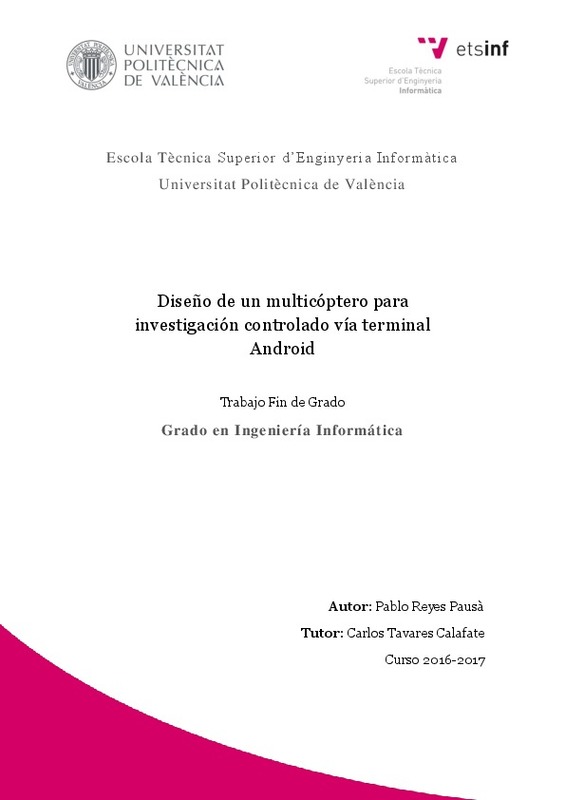JavaScript is disabled for your browser. Some features of this site may not work without it.
Buscar en RiuNet
Listar
Mi cuenta
Estadísticas
Ayuda RiuNet
Admin. UPV
Diseño de un multicóptero para investigación controlado vía terminal Android
Mostrar el registro sencillo del ítem
Ficheros en el ítem
| dc.contributor.advisor | Tavares de Araujo Cesariny Calafate, Carlos Miguel
|
es_ES |
| dc.contributor.author | Reyes Pausà, Pablo
|
es_ES |
| dc.date.accessioned | 2017-09-05T15:11:54Z | |
| dc.date.available | 2017-09-05T15:11:54Z | |
| dc.date.created | 2017-07-17 | |
| dc.date.issued | 2017-09-05 | es_ES |
| dc.identifier.uri | http://hdl.handle.net/10251/86467 | |
| dc.description.abstract | [EN] The current project arises from the need to create a generic remote control system applicable to all open flight controllers based on the MAVLink protocol, as well as the need to create a drone of the hexacopter type for research purposes. Regarding the proposed remote control system, it is based on mobile terminals in order to replace the traditional radio transmitter, which saves costs and allows improving the security of the link between controller and multicopter. In order to perform such functions, the mobile terminal will be linked to the flight controller through single board computer (SBC). Specifically, the PIXHAWK flight controller will be responsible for controlling the drone hardware. As for the SBC, this will be a Raspberry Pi 3 that will serve as both interpreter between the mobile device and the flight controller, and a device to provide a secure WiFi connection between the Raspberry Pi and the Android mobile device based on the IEEE 802.11ª standard. With this, it is intended that the mobile device becomes a radio transmitter with full functions.This way, it will have an ad hoc design from commercial components for the purpose of achieving a dron with great autonomy, and flexible enough to allow it to expand according to the research needs that may arise. For the design of the hexacopter, 3D printing techniques have been used to create custom pieces, and the hardware was focused on energy efficiency. Finally, a test was performed where the hardware and software that compose the drone were tested. | es_ES |
| dc.description.abstract | [ES] El presente proyecto nace de la necesidad de crear un sistema de control remoto genérico aplicable todos los controladores de vuelo abiertos basados en el protocolo MAVLink, así como de la necesidad de crear un dron del tipo hexacóptero para labores de investigación. Respecto al sistema de control remoto propuesto, éste se basa en terminales móviles de manera que reemplace la emisora de radiocontrol tradicional, lo cual permite ahorrar costes, así como mejorar la seguridad del enlace entre controlador y multicóptero. Para poder realizar dichas funciones, el terminal móvil se enlazará a la controladora de vuelo mediante un computador de placa simple (SBC). Concretamente, la controladora de vuelo PIXHAWK será la encargada de actuar sobre el hardware del dron; en cuanto a la SBC, ésta será una Raspberry Pi 3 que servirá tanto de intérprete entre el dispositivo móvil y la controladora de vuelo, como de dispositivo para proporcionar una conexión WiFi segura entre la Raspberry Pi y el dispositivo móvil Android basándose en el estándar IEEE 802.11a. Con ello se pretende que el dispositivo móvil se convierta en una emisora radiocontrol con plenas funciones. En lo que respecta al hexacóptero desarrollado, tendrá un diseño ad hoc a partir de componentes comerciales con el propósito de lograr un dron con gran autonomía, y lo suficientemente flexible como para permitir ampliarlo según las necesidades de investigación que puedan surgir. Para el diseño del hexacóptero se han utilizado técnicas de impresión 3D para la creación de piezas a medida, y un hardware enfocado a la eficiencia energética. Finalmente, se realizará un ensayo en el cual se comprobará el correcto funcionamiento del hardware y software que componen el dron. | es_ES |
| dc.format.extent | 84 | es_ES |
| dc.language | Español | es_ES |
| dc.publisher | Universitat Politècnica de València | es_ES |
| dc.rights | Reconocimiento - No comercial (by-nc) | es_ES |
| dc.subject | Drone | es_ES |
| dc.subject | Raspberry Pi | es_ES |
| dc.subject | PIXHAWK | es_ES |
| dc.subject | Android | es_ES |
| dc.subject | 3D printing | es_ES |
| dc.subject | Impresión 3D | es_ES |
| dc.subject.classification | ARQUITECTURA Y TECNOLOGIA DE COMPUTADORES | es_ES |
| dc.subject.other | Grado en Ingeniería Informática-Grau en Enginyeria Informàtica | es_ES |
| dc.title | Diseño de un multicóptero para investigación controlado vía terminal Android | es_ES |
| dc.type | Proyecto/Trabajo fin de carrera/grado | es_ES |
| dc.rights.accessRights | Abierto | es_ES |
| dc.contributor.affiliation | Universitat Politècnica de València. Escola Tècnica Superior d'Enginyeria Informàtica | es_ES |
| dc.contributor.affiliation | Universitat Politècnica de València. Departamento de Informática de Sistemas y Computadores - Departament d'Informàtica de Sistemes i Computadors | es_ES |
| dc.description.bibliographicCitation | Reyes Pausà, P. (2017). Diseño de un multicóptero para investigación controlado vía terminal Android. http://hdl.handle.net/10251/86467. | es_ES |
| dc.description.accrualMethod | TFGM | es_ES |
| dc.relation.pasarela | TFGM\57050 | es_ES |
Este ítem aparece en la(s) siguiente(s) colección(ones)
-
ETSINF - Trabajos académicos [5160]
Escola Tècnica Superior d'Enginyeria Informàtica






